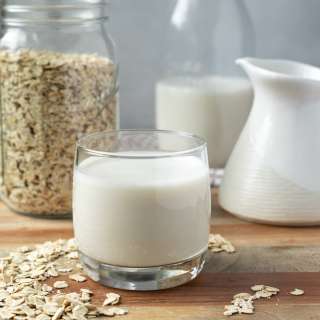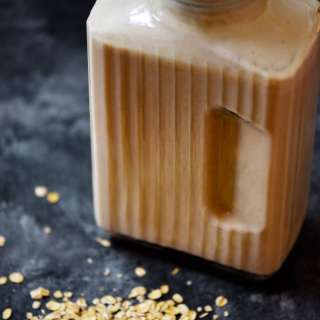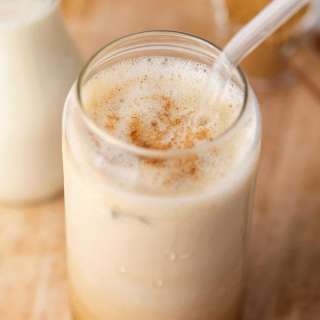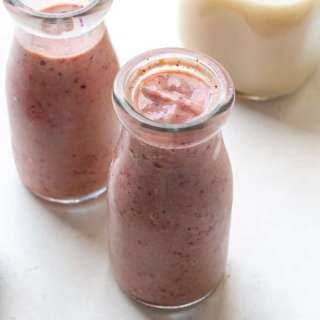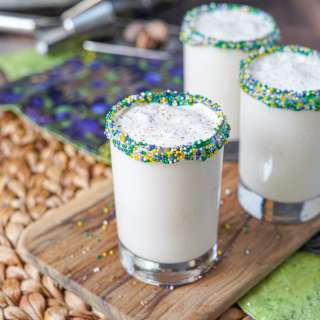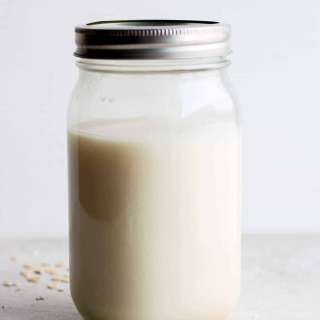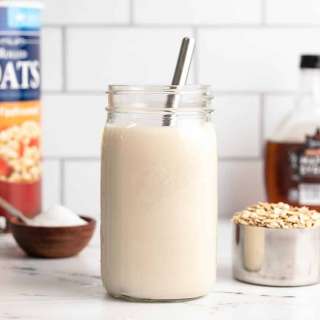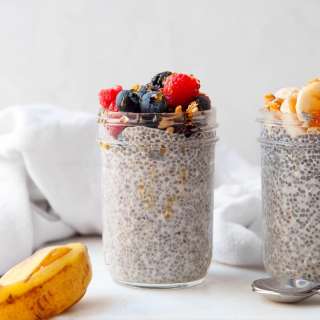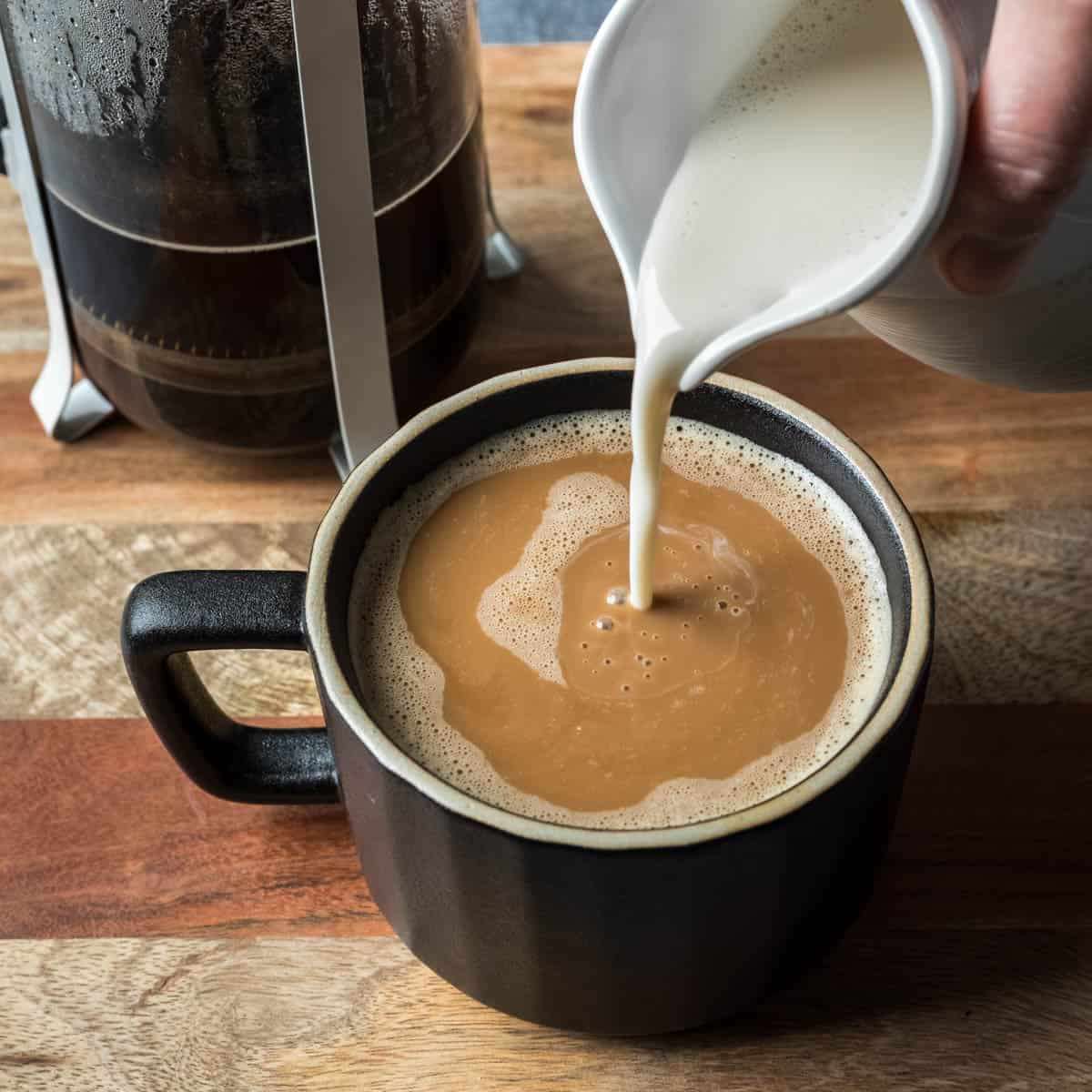
Oat Milk Creamer Recipe With Enzymes (NEW and Improved!)
User Reviews
5.0
42 reviews
Excellent

Oat Milk Creamer Recipe With Enzymes (NEW and Improved!)
Report
Want to lear how to make the best dairy-free oat milk creamer? After a lot of research and testing, we figured out an easy and affordable way to make vegan coffee creamer with oats. It has that perfectly subtle, sweet cream flavor that tastes so great in coffee... and there's no sliminess. See the Notes section below for delicious flavor variations!Yield: makes 2 ¼ cups, or 18 fluid ounces
Share:
Ingredients
- 1¼ cups rolled oats certified gluten-free, if needed
- 3 cups water
- 1 capsule vegan digestive enzyme tap for product; should contain amylase and glucoamylase
- pinch of sea salt
- ½ teaspoon pure vanilla extract or clear imitation vanilla
- ½ cup raw cashews or 2½ tablespoon flavorless oil
- 1 teaspoon sunflower lecithin, optional emulsifier
Instructions
Soak, blend & strain:
- Put the rolled oats in a blender. Blend for about 5 seconds or until they're the consistency of coarse flour. Pour oat flour into a large bowl.
- Open one digestive enzyme capsule and dump the powder into the bowl (discard the capsule).
- Heat the water to approximately 150 degrees F (66 C). I like to microwave it in a large bowl. At this temp it will feel very hot but won't immediately scald you.
- Pour the hot water into the bowl with the oat flour and enzymes, and stir well. For reference, use a spoon to taste the oat water (it will be very bland). Set aside for 30-45 minutes. I like to stir occasionally during this time. After 30 minutes, taste the water again. It should now taste slightly sweet. If it doesn't, either the enzymes used aren't effective or the water wasn't the correct temperature. If you think the water was too cool, microwave the bowl for about 30 seconds to raise the temperature, and check again in 15 minutes.
- Rinse out the blender to remove any oat flour remnants, and pour the oat-water mixture into the blender. Starting on low, quickly increase to high speed, and blend for about 10 seconds. You don't need to blend long since the oats were already broken down to flour. If not using a Vitamix or other high-speed blender, you may need to blend in two batches due to the large volume.
- Use a nut milk bag to strain the oat milk into a large heavy-bottom pot or saucepan. I like to place one nut milk bag inside another, for a double layer. Or you can strain it twice using the same bag (rinse in between uses). Since the starch has been broken down into sugars, it's fine to squeeze the bag. However, if you notice that it feels slimy, this means the enzymes did not work. Review the tips in the Notes section below before proceeding.Save the oat pulp for baking or add it to smoothies.
Simmer:
- Over medium heat and whisking frequently, slowly bring the oatmilk creamer to a simmer. Aim for 195 degrees F. If you don't own a thermometer, look for these visual clues: tiny bubbles around the edges and slight movement in the center, like it's just about to reach a full simmer. Whisking, maintain this low simmer for another 20 seconds or so, then remove from heat. Whisk in the salt and vanilla.
Add fat for richness:
- Let cool for about 20 minutes or until barely warm (so it's safe to put in the blender). Rinse out the blender jar, and return the creamer to the blender. For the cashew option, add them to the blender, and blend on high until completely smooth. Don't worry about over-blending! It's better to blend too much than too little in this case.For the oil option, while blending on high, remove the cap from the pour spout and slowly drizzle in the oil. Add the sunflower lecithin and blend for a few more seconds.
- Pour into a clean jar and place in the refrigerator uncovered. Once cool, cover the jar. Keep refrigerated and use within 5 to 6 days.
Notes
- Enzymes - Look for a digestive enzyme blend similar to this 365 product or this one by NOW Supplements. These are the only two I've tested. Based on my experience, you'll get the best results if it contains both amylase and glucoamylase.
- Flavored Oat Creamer Ideas
- Per 1 cup (8oz) of oat milk creamer, add:
- cinnamon roll: ½ teaspoon ground cinnamon + 2 to 4 teaspoon sweetener
- mocha mint: 2 teaspoon cocoa powder + ⅛ teaspoon peppermint extract + sweetener
- toasted almond: scant ½ teaspoon almond extract + a few extra drops vanilla extract + sweetener
- pumpkin spice: 1 teaspoon pumpkin spice + 1 tablespoon maple syrup or sweetener of choice
- Tips & Troubleshooting:
- For a lightly sweet cup of coffee, start with 2 teaspoons of sugar per 8 ounces of creamer.
- If you prefer a sweeter coffee creamer, you may want to use as much as 2 tablespoon sugar/sweetener per 8 ounces of creamer.
- cinnamon roll: ½ teaspoon ground cinnamon + 2 to 4 teaspoon sweetener
- mocha mint: 2 teaspoon cocoa powder + ⅛ teaspoon peppermint extract + sweetener
- toasted almond: scant ½ teaspoon almond extract + a few extra drops vanilla extract + sweetener
- pumpkin spice: 1 teaspoon pumpkin spice + 1 tablespoon maple syrup or sweetener of choice
- RECIPE UPDATE: Since I first shared the recipe, I've heard from a few people who said their oat milk still thickened when heated. Initially, I thought the most likely issue was the type of enzymes used (which is still a possibility). But now I'm more convinced it's due to differences in rolled oats (thick cut). This is why I've changed the instructions to include blending the oats into flour. This solves the problem by allowing the enzymes to easily access the starches.
- When you first stir the hot water and oat flour together, taste the water for reference. After soaking for 30 minutes, the water should taste lightly sweet. The difference should be obvious. If it doesn't taste sweeter than before, either the enzymes aren't working properly or the water wasn't the correct temperature. If you think the water was too cool, microwave the bowl for 20 to 30 seconds to raise the temperature, and check again in 15 minutes.
- That said, if you notice that the oat milk feels slimy while straining it, this means the enzymes did not work. There's no point in heating it in the next step, unless you want to turn it into oat "pudding." You can always salvage the batch by adding vanilla and a sweetener and enjoying it for dessert! Then review all of the steps, hopefully figure out why the enzymes didn't work, and try again!
Nutrition Information
Show Details
Serving
4tablespoon
Calories
84kcal
(4%)
Carbohydrates
9g
(3%)
Protein
3g
(6%)
Fat
4g
(6%)
Sodium
50mg
(2%)
Nutrition Facts
Serving: 9servings
Amount Per Serving
Calories 84 kcal
% Daily Value*
| Serving | 4tablespoon | |
| Calories | 84kcal | 4% |
| Carbohydrates | 9g | 3% |
| Protein | 3g | 6% |
| Fat | 4g | 6% |
| Sodium | 50mg | 2% |
* Percent Daily Values are based on a 2,000 calorie diet.
Genuine Reviews
User Reviews
Overall Rating
5.0
42 reviews
Excellent
Other Recipes
You'll Also Love
Toasted Marshmallow Creamer (DF friendly Coffee Creamer)
North American, American, Canadian
5.0
(12 reviews)
Get the Recipe Ridiculously Easy Homemade Coffee Creamer (without Sweetened Condensed Milk)
American
5.0
(15 reviews)
